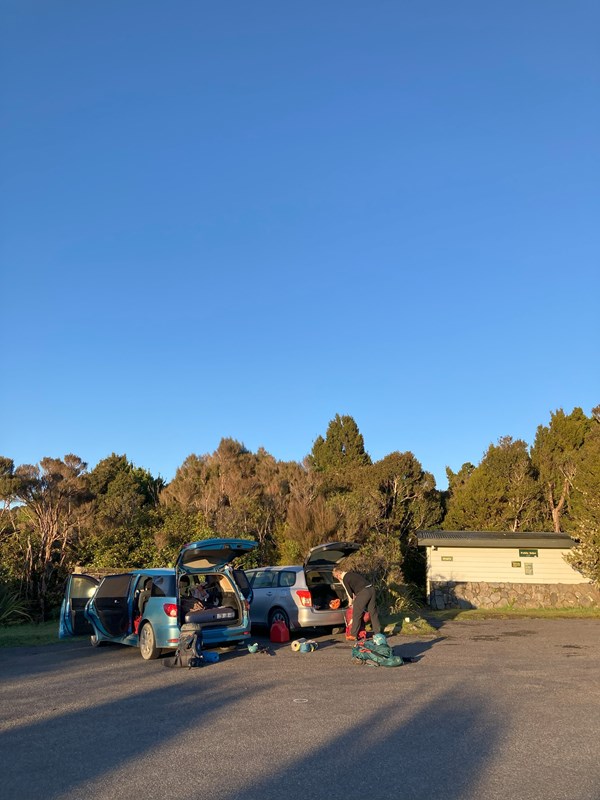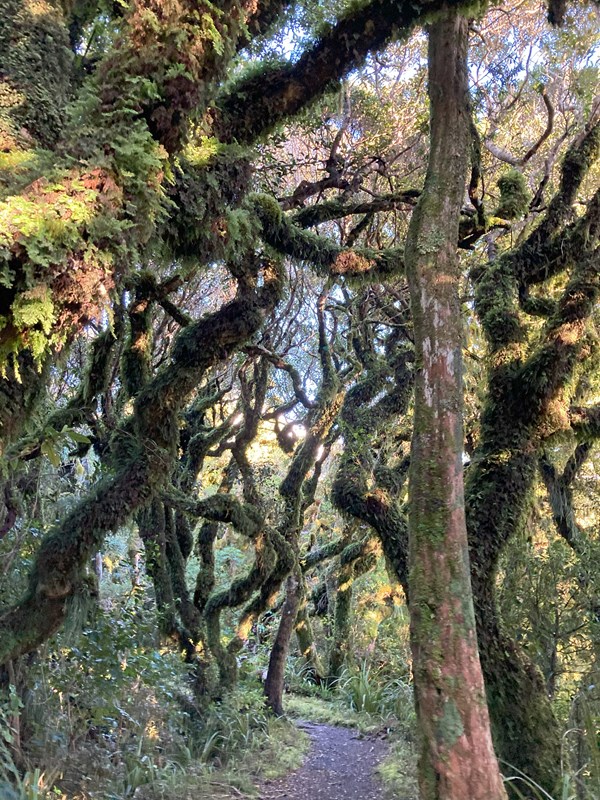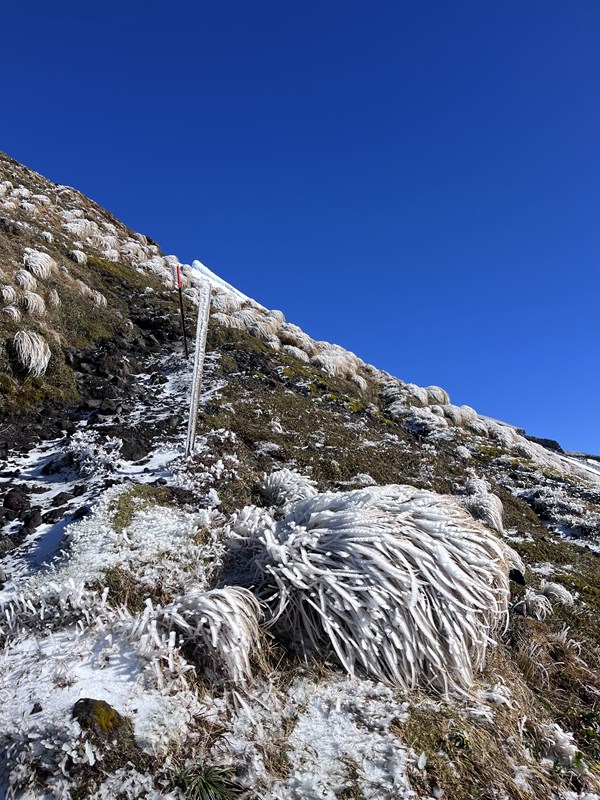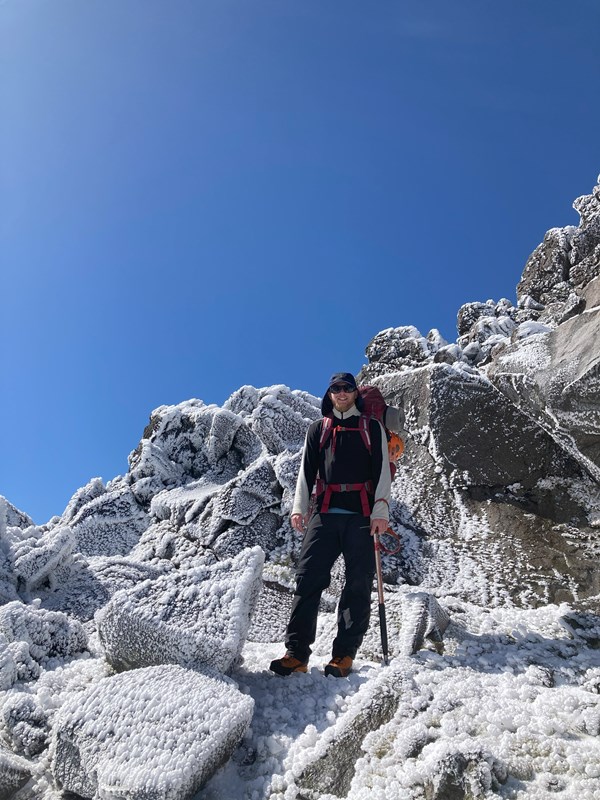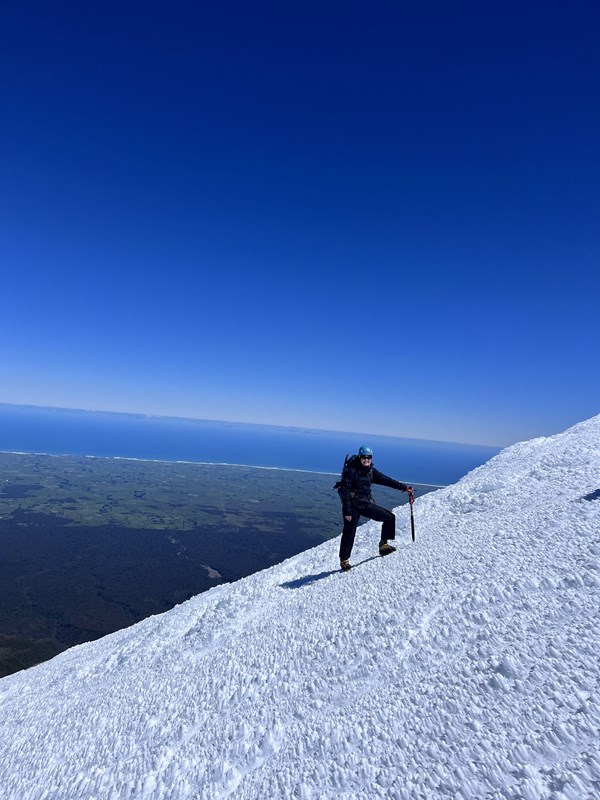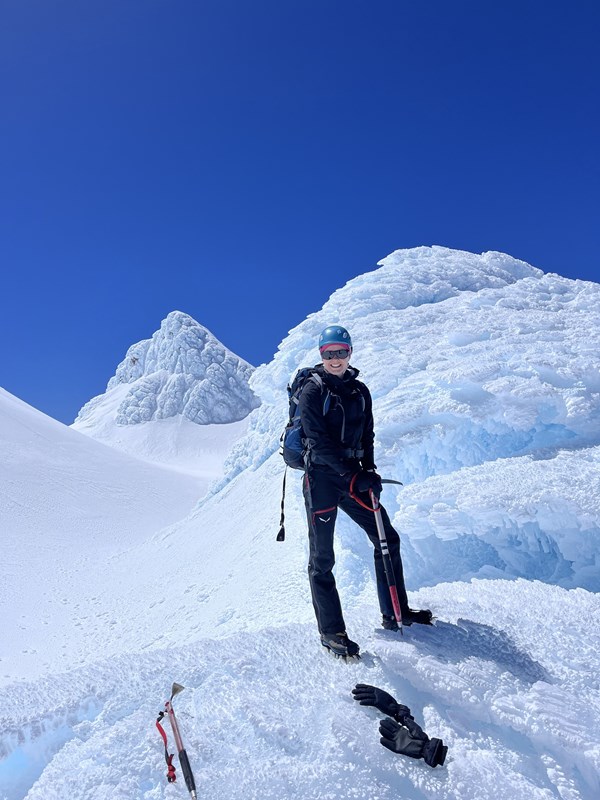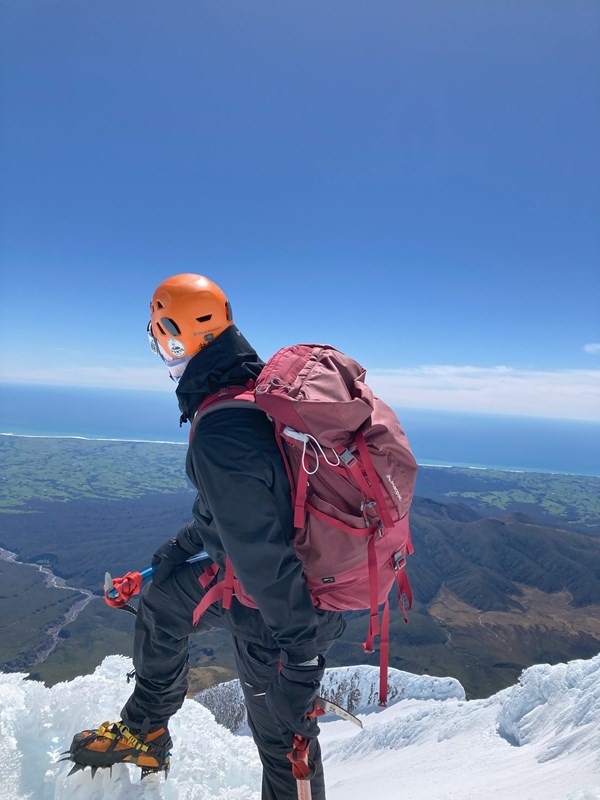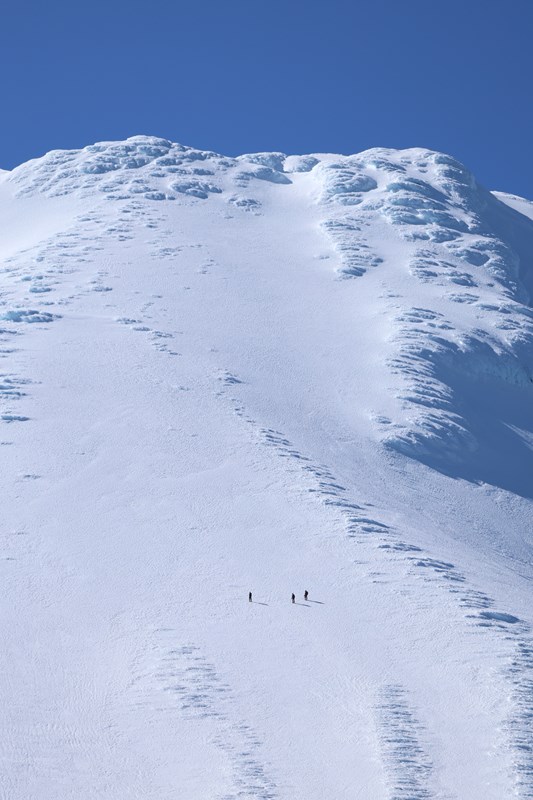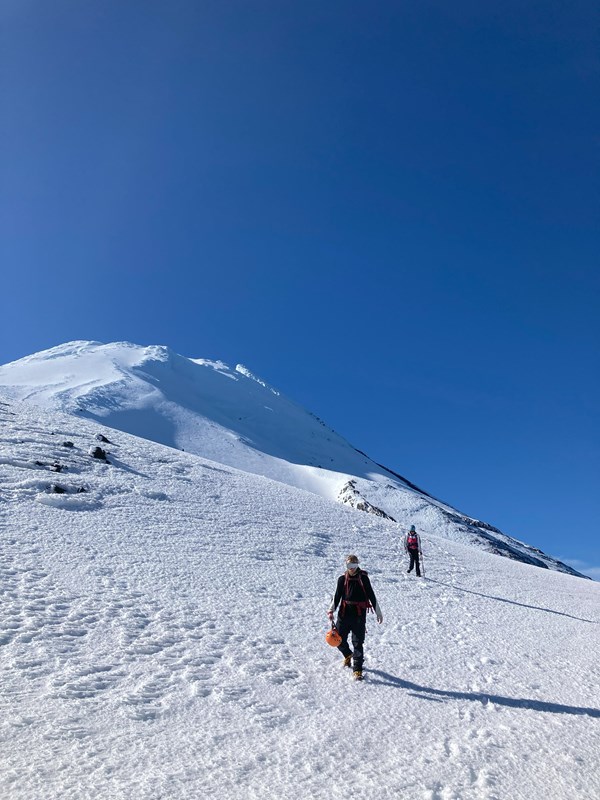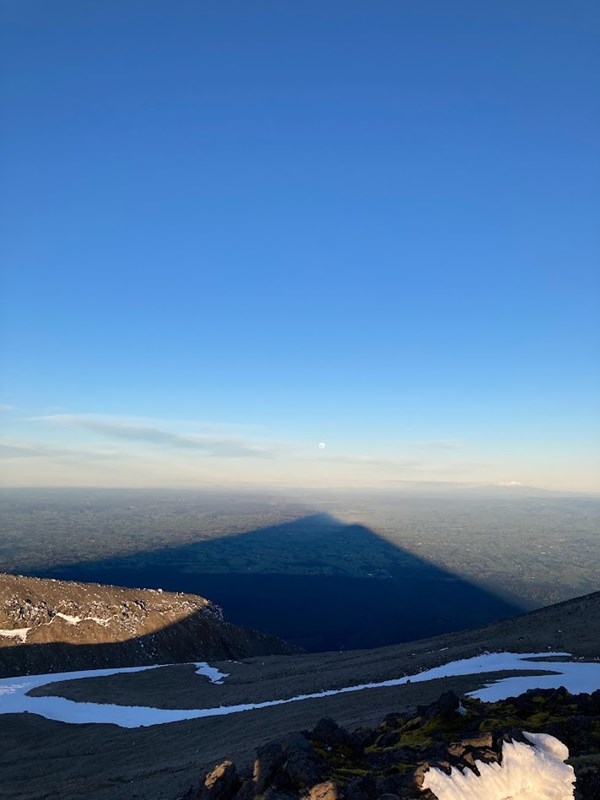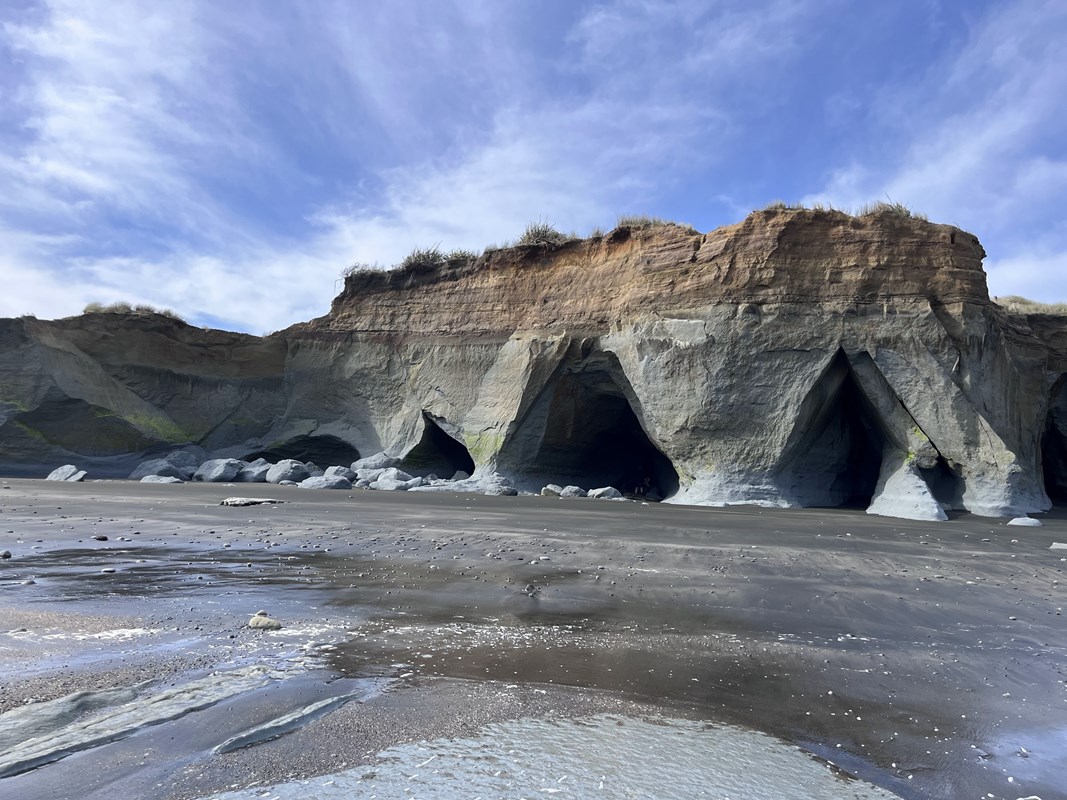By James Sales, 27 October 2023
Mt. Taranaki Via Syme Hut
27-29 October 2023
James Sales (Leader), Louisa Charlotte Wind, and Anna Unterrainer
As was submitted for Heels in August 2024:
I always wanted to summit Mt. Taranaki but apart from our first attempt earlier in the year, I had not revisited the idea - until Alex put this trip up on the website. Alex never ended up going so I was the trip leader.
In late October, we woke up at sunrise after a good sleep in our cars, and we started up the Syme Hut track from the Dawson Falls Carpark. Earlier in the year when we tried, the mountain was covered in clouds and we hardly made it up the wooden steps when we turned around due to 100kph wind. Mt. Taranaki is known for its high wind and quick-changing weather.
This time, it was freezing when we went to bed, and likewise the next morning, but we awoke to such a lovely glowing morning, no wind and bluebird skies! The walk through the bush was lovely and pleasant, but by the time we were out of the tree line, we were sweating. On our way through the tussock, we dodged icy wooden steps and frozen puddles. Visibility was perfect; there was no haze or cloud – we could see Mt. Ruapehu and Mt. Ngauruhoe on the horizon perfectly.
The scoria slope was covered in a considerable layer of puffy frost from the night before. This was accompanied by a build-up of ice on the leeward sides of the tussock grasses, sometimes 10cm or more; and the leeward side of marker poles, sometimes 30cm in length. The rocks at the top of the scoria slope were plastered with rime ice.
Leaving the car park at about seven, it must've taken us about four hours to get to the hut, as we had lunch there before deciding to summit that day. There is no path as such, and any way up is forward - however there is an opening on the crater rim that you should aim for. As we climbed, we encountered rime ice in the form of tens of thousands of finger-like structures. The face of Mt. Taranaki was solid with ice.
The last dozen metres before the crater were very steep. We took this part very slowly. After all, Mt. Taranaki is known for bullet-proof ice which makes arresting impossible. Life would have gotten exciting quickly if one of us had fallen. The top itself was an icey wonderland! It was so calm and quiet but the sun was scorching.
It took perhaps three hours to get to the top, we spent about an hour on the summit, then perhaps one and a half down. The descent was hot and slow. By the time we got back to the hut, the evening colours and shadows were just forming. Even before the sun had set, the temperature dropped so quickly that we could see the water drops off the roof freeze as we watched them, and soon the drips off the roof stopped entirely. The beautiful setting sun cast the mountain’s shadow across farmland below us. In my merino hoodie, hooded puffer jacket, silk sleeping bag liner, and -5C sleeping bag, I was comfortable overnight.
Sunday was bluebird too. We wrapped up warmly to leave Rangitoto Flat but when we were down the scoria slopes, we all had to stop and take off layers. By the time we got to the car park, it was like a summer’s day. The temperature contrast between the top and the carpark was phenomenal.
On our way back, I stopped to get cider, which we shared at a beach we checked out that had caves strewn with rocks with fossils in them. We made our way back to Wellington, feeling happy with what we had accomplished.
Addendum notes:
-
We drove up on Friday night after work. We saw so many possums once we had driven past the cattle stop at the entrance to the National Park. It is like prime habitat for them.
-
We followed the Fanthams Peak Track and the Southern Summit Route. From Syme Hut, there is a series of marker poles that lead you down onto Rangitoto Flat, but from then on there isn’t a marked track. It is not a very intimidating mountain once you are on it, and once you are at Syme Hut, don’t get too caught up on route (especially in this dense ice with no rock, you won’t walk into any terrain traps and the snow/ice conditions and temperature was not such that we would be concerned of falling ice/snow). Literally it is just straight upwards, aiming for the fairly obvious exit/entry amongst the ice on the crater rim - keep on the Syme Hut side. Back down again is self-explanatory.
-
Unlike what the trip description suggests, no need for rope. In the conditions we did it in, it is just a MC grade 1 climb, but the only crux part is the steep section just below the summit. This can just be navigated by careful steep walking or front uncomfortable pointing (as it wasn’t really steep enough for that). Evidently rope is more hassle than it was worth and we left harnesses and rope in the car. Also unlike what the trip description suggests, don’t use the club cookers, take your own and fuel as we did.
-
We took tents, sleeping mats and all, expecting the hut to be choker, but it was empty when we got there. A few more people floated up to stay the night at the hut by the time we got back from the summit. And how lucky we all were as we witnessed the most beautiful sunset that night.
-
One of us practised self-arrest on the way down, towards the bottom of the slope. She was surprised how long it took to stop from just a light push. A far cry from stopping in a mere two metres in the snow on Mt Ruapehu during snowcraft!
-
Trip leaders should carry two pairs of eye protection. Someone's sunglasses broke literally as we left the hut as she sat in the doorway, so I gave her my sunglasses and I wore my snow goggles.
-
I learned the usefulness of acquiring a buff as opposed to using a merino balaclava as sun protection!
-
It seems it is customary in New Zealand to climb in high winds that are gale force, that people from other countries of a calmer more predictable mountains are wary of, whereas we barely bat an eye. However being so close to the sea, weather can of course change quickly. The first time, the weather was drizzly, cloudy, and very windy. We did the Pouakai Circuit instead that time.
-
The beach we visited is called Waverley Caves.
-
Photos courtesy of Anna and Loiusa.
